Relā – रेला
Quick Definition: A theme-and-variation composition similar to the kayda, but performed at higher speeds. Common in both tabla solo and accompaniment.
Literal Meaning: rushing stream; torrent; flood
Example Rela
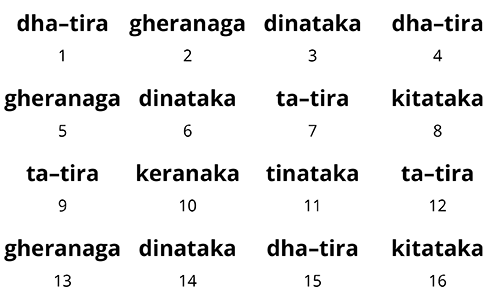
Performed in 1x and 2x Speeds:
Introduction to Rela
New listeners to the tabla are often amazed by the speed of some performances. In many cases, what they are hearing is a rela.
The rela is a popular theme-and-variation type composition that is similar in form to the kayda. The main difference is that the rela is composed for high speeds, and so it uses phrases which are usually more smooth and flowing than the kayda.
The term rela appears to come from its literal meaning: a "rushing stream" or "torrent". However, there is a common myth that the term rela comes from fast trains (“rail”). But as Chhotelal Misra and other writers have pointed out, this is obviously false since the term rela in classical Indian music is much older than trains.
In modern tabla, the rela has become especially popular among both players and audiences. And particular types of relas are now frequently performed by players from all gharanas.
However, some traditionalists complain that relas are overused, especially in accompaniment. It is also now common for some players to perform kaydas at rela speeds, and so the difference between kaydas and relas is not always clear.
General Rela Characteristics
Most people agree on the following rela characteristics:
- Relas are composed in order to be played fast.
- Relas should create an effect which is smooth and flowing.
Related to the second point, Chhotelal Misra also writes that relas should be played easily, or "comfortably", at high speeds (if you an advanced tabla player, of course). This points to the flowing nature of typical rela phrases.
Rela versus Kayda
Because relas should create a flowing effect, rela phrases usually have less contrast than kaydas phrases. There are exceptions to this, but I have found this to be true more often than not.
Sadanand Naimpalli describes the rela as an "unbroken chain" where "the end of one phrase and the beginning of another are interwoven" (p. 57).
And Aneesh Pradhan writes that the rela is an "…extendable structure, which employs a continuous flow of intricately woven strokes played at very high speed to give a drone-like effect" (2011).
Both of these descriptions suggests less contrast in bol than the typical kayda.
Many rela themes also do not have the typical ending phrases of kaydas (tinnakina, tunakata, etc.). Some relas do have this type of ending (such as Benares Rela 1 on this site), but many do not (such as Benares Relas 3, 4, and 5).
In performance, most kaydas are heard only in tabla solo, while relas are heard in both accompaniment and tabla solo. In accompaniment especially, rela pieces are used quite liberally and creatively.
In tabla solo, relas are developed similarly to kayda variations. However, because relas generally have less contrast and variety of bols, there is usually less scope for development.
Rela Bols
Some players say that only certain bols may be used in relas—and this may be true in their tradition—but there is no agreement on this across gharanas.
However, some bols are especially common due to their fast and flowing nature. Among the most common rela bols are:
- tirakiṭa – तिरकिट
- gheṛanaga – घेड़नग
- dheradhera – धेरधेर
- dhinagina – धिनगिन
- dhāṛagina – धाड़गिन
Kinds of Relas
Different lineages may have different kinds of relas with different names. In this section, we will look at some of the common types of relas mentioned in Chhotelal Misra’s theory book Tal Prabandh. These relate most clearly to the Benares relas presented on this site.
In many cases, relas in Benares are no different from relas in other gharanas. However, some popular kinds of relas are less common in Benares, or have different fingerings, or are similar to some bants. With time, I hope to present more examples of relas from other gharanas.
Swatantra Rela
The two main kinds of relas mentioned in Chhotelal’s books are the swatantra rela (स्वतंत्र रेला), or "independent rela", and the rela made from a kayda. No theoretical description is given of these two forms, only examples.
The swatantra rela is independent in the sense that it stands alone as its own composition.
The example given above is a swatantra rela:

This rela was famously played by Ahmedjan Thirakwa Khan, and also by Anokhelal Misra, though it is not commonly played in Benares outside of Anokhelal’s lineage.
Rela Made from Kayda
Relas made directly from kaydas are also common.
The rela below uses common kayda bols:
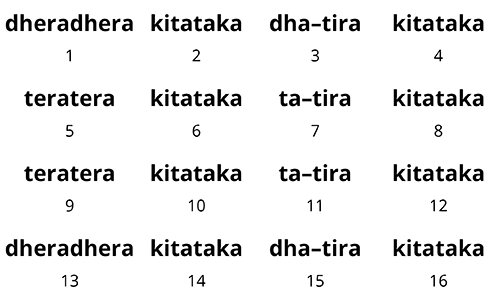
The two main phrases (and their khali counterparts) in this rela are:
- dheradhera kitataka
- dha–tirakitataka
These bols are found in a number of common kaydas, such as Benares Kayda 10 on this website. Corresponding phrases are underlined:
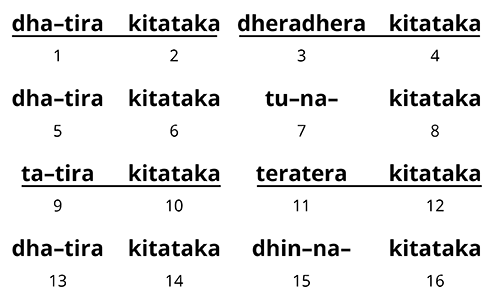
Note that the rela above does not have the kayda’s ending phrase of tu-na-kitataka
Theka-Rela
A theka-rela follows the general pattern of a particular theka, including the tali-khali pattern of the theka bols. In some cases, it will also follow the exact bols of the theka, but with other bols in between.
For example, here is the tintal theka:
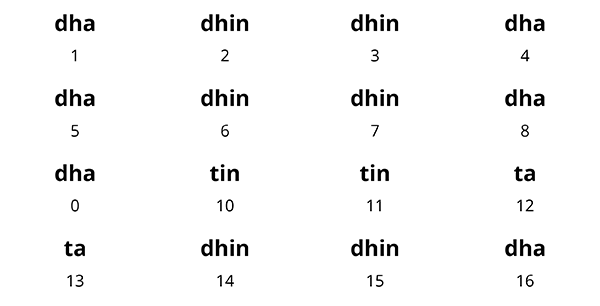
And here is a theka-rela in tintal. In this example, the bols which fall on the matra (in bold ) match the bols of the tintal theka:

In other theka-relas, the bols which fall on the matra do not match those of the theka exactly, but will substitute a different bol:
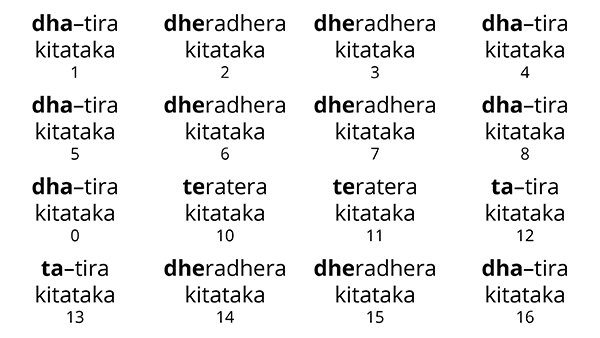
In comparison to the theka, dhe is used instead of dhin, and te is used instead of tin. But they follow the same tali-khali pattern as the theka.
Angusthane Rela
The angusthāne relā (अँगुश्ताने का रेला ) is a style of rela that is especially popular today. It is called "angusthane" because of the particular techniques that are used, but otherwise it is the same as any common rela.
The literal meaning of term angusthana is "thimble" or a "ring worn on the thumb." But it is also related to the word "finger."
In either case, every tabla player that I have asked says that angusthane means "played with the fingertips". And the most common fingertip bols in angusthane relas are dharagina and dhinagina. There may be other bols in the rela, but these bols are usually prominent.
Below is a pure angustane rela using only the bols dharagina and dhinagina:

And here in another angusthane rela which uses the same bols plus the bol takataka:

Performed in 1x and 2x Speeds:
(from Benares Rela 5)
(Note: This rela is played by many different players from different gharanas, though most players outside of Benares use different techniques.)
See the Compositions page for more rela examples.
References
Kippen, James. The Tabla of Lucknow – A Cultural Analysis of a Musical Tradition. Cambridge: Cambridge University Press, 1988.
Misra, Chhote Lal. Tabla Granth. New Delhi: Kanishka Publishers, 2006. (Hindi)
—. Playing Techniques of Tabla – Banaras Gharana. New Delhi: Kanishka Publishers, 2007.
—. Tal Prabandh. New Delhi: Kanishka Publishers, 2006. (Hindi)
Naimpalli, Sadanand. Theory and Practice of Tabla. Mumbai: Popular Prakashan Pvt. Ltd., 2005.
Pradhan, Aneesh. Tabla: A Performer’s Perspective. Aneesh Pradhan, 2011 (self-published eBook)